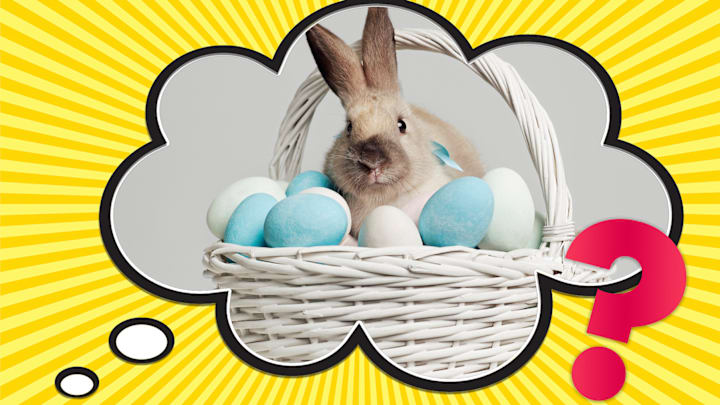The Easter bunny is an anthropomorphic, egg-giving rabbit who sneaks into homes the night before Easter to deliver baskets full of colored eggs, toys, and candy. Even if you allow for miracles, angels, and pancake Jesus, the Easter bunny still really comes out of left field.
So how did a rabbit become associated with a holiday commemorating the resurrection of Jesus Christ in the first place? The Easter bunny’s origin story is a bit complicated—and might have more to do with the spring season and old pagan traditions than it does with Christianity.
Why Is a Bunny Connected to Easter?
The Bible doesn’t make any mention of a good-natured rabbit hopping from house to house to deliver baskets of eggs to kids on Easter Sunday, so to understand the Easter bunny’s roots, we have to dig deeper. Because spring is the season of rebirth and renewal, some sources suggest that may be part of how bunnies (along with hares) became connected to the holiday.
Known for their rapid reproduction rate, hares symbolize fertility in many cultures. They were also closely linked to certain goddesses, like Eostre (also known as Ostara). In ancient pagan tradition, the Anglo-Saxon goddess Eostre ruled over the dawn and was associated with springtime and fertility. Not only that, but according to legend, she once saved a wounded bird whose wings had been frozen in the winter cold by transforming it into a hare. To give thanks, the hare supposedly returned once a year during her festival to lay colored eggs, as they were seen as emblems of life renewing itself.

As Christianity spread, it was common for missionaries to practice some good salesmanship by placing pagan ideas and rituals within the context of the Christian faith. Part of how they pulled this off was by transforming pagan festivals into Christian holidays (like Christmas). The Eostre festival occurred around the spring equinox on March 20, so it was around the same time that Christians celebrated Christ’s resurrection. The two celebrations eventually became one, with Eostre (spelled Eastre in Old English) likely lending her name to the holiday.
With the kind of blending that was going on among the cultures, it would seem only natural that the pagans would bring the hare and egg images with them into their new faith (the hare later became the more common rabbit).
Why Does the Easter Bunny Bring Eggs?
Apart from the story about Eostre and her magic hare, there are other theories as to why bunnies are connected to Easter, and why eggs are so strongly linked to the holiday. Within Christianity, eggs are seen as representative of Christ’s resurrection. Christians typically refrain from eating them during Lent, so preserving them to decorate and devour later was seen as a way of marking the start of springtime celebrations.
The custom of using eggs around Easter is also mentioned in Germanic writings from the late 1500s. The Germans converted the pagan hare image into Oschter Haws (or Osterhase), who lays a clutch of colored eggs each year in gardens as gifts for good children, who would then go on hunts for them. In the 16th and 17th centuries, Easter hare hunts were also commonplace in places like England. This might have stemmed from old European folk traditions, which held that witches often took the form of hares and caused mischief during the winter months. Eating hare around the holiday was seen as a way of preventing witches from causing further mayhem in the spring.

Oschter Haws came to America with Pennsylvania Dutch settlers in the 1700s, and evolved into the Easter bunny as it became entrenched in American culture. Over time, the bunny started bringing chocolate and toys in addition to eggs. While Easter egg decoration dates back to at least the 13th century, the chocolate rabbit is believed to have originated with Germans in the 18th century; they even started making Oschter Haws pastries in the 19th century, too.
The Easter bunny even went with European settlers to Australia—as did actual bunnies. These rabbits, fertile as they are, got a little out of control, so the Aussies regard them as serious pests. The destruction they’ve caused to habitats is responsible for the major decline of some native animals and some tremendous damage to crops. It is, perhaps, not a great idea to use an invasive species as a symbol for a religious holiday, so Australia has been pushing the Easter bilby, an endangered marsupial that kind of looks like a bunny if you squint, as an alternative.
Have you got a Big Question you’d like us to answer? If so, let us know by emailing us atbigquestions@mentalfloss.com.
A version of this story originally ran in 2016 and has been updated for 2024.
